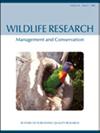野生动物研究50周年
IF 1.6
3区 生物学
Q3 ECOLOGY
引用次数: 0
摘要
我们最忠实的读者可能会认为野生动物研究(WR)已经存在了。要了解作者归属和声明的完整列表,请参阅超过50年的论文结束。严格来说,如果你把它最初的化身和名称——CSIRO野生动物研究——包括在内,他们是正确的。然而,这是半个世纪以来,该杂志目前的形式是一个充满活力和影响力的国际*通信:安德里亚·c·泰勒生物科学学院,莫纳什大学,克莱顿,维克3800,澳大利亚电子邮件:andrea.taylor@monash.edu研究景观,我们正在庆祝第50卷第1期的介绍。值得注意的是,这一卷看到杂志从每年出版8期到12期,反映了它持续的成功和增长。我们从WR的简史开始,强调它的发展成为一个值得信赖的高质量研究来源,为世界舞台上的野生动物科学家、管理者和政策制定者提供证据基础,作为处理编辑:Phil Stevens,以及我们对未来发展的展望。CSIRO出版公司的出版主管Andrew Stammer最近提醒我们,上世纪中叶左右澳大利亚出版社成立的主要推动力是什么。考虑一下战后澳大利亚科学家不得不在英国和美国期刊上发表文章的经历,这需要通过海运进行每一个相关的过程——提交、审稿、收到审稿、再提交、然后收到并返回证明。对当地科学家来说,建立一家澳大利亚出版商的重要性怎么强调都不为过。1956年,CSIRO野生动物研究是CSIRO与新成立的澳大利亚科学院合作推出的一组期刊之一,由标准委员会进行质量监督,并受1949年科学和工业研究法案(Cth)的监管。澳大利亚早期的野生动物研究非常关注入侵脊椎动物的生物学、影响和控制,特别是欧洲兔(Oryctolagus cuniculus),其中大部分工作是由CSIRO的科学家完成的(例如Mykytowycz 1956)。然而,到1974年,作者基础和内容已经大大多样化,包括来自广泛的研究机构和大学的贡献-最初来自全国各地,然后越来越多地来自国际。该杂志更名为《澳大利亚野生动物研究》,然后更名为《野生动物保护区》,反映了研究参与范围的扩大。鉴于野生动物和自然资源研究人员和管理人员面临的问题是全球共享的,并且以外向的研究重点更有效地解决了这些问题,该杂志继续发展,并提供了更多来自国际合作和研究小组的内容。《科学》发展的另一个关键时刻是在2000年代末,由内部编辑监督(后来由Camilla Myers负责)转向任命来自学术界的外部总编辑(EiCs)。Piran White, Andrea Taylor和Stan Boutin在一篇概述新模型的社论中确立了这些角色(White et al. 2009)。查尔斯·克雷布斯,以其对野生动物生态学的杰出贡献和与澳大利亚野生动物管理协会(AWMS)的长期参与,收到:2022年11月29日接受:2022年12月9日出版:2023年1月19日WR,被任命为编辑委员会主席。建立了一个多学科和国际副编辑团队,以支持eic对期刊日益多样化的投稿做出决定。对…有重要贡献的本文章由计算机程序翻译,如有差异,请以英文原文为准。
Wildlife Research turns 50
Our most loyal readers might be thinking that Wildlife Research (WR) has been around For full list of author affiliations and declarations see end of paper longer than 50 years. Strictly speaking, they are correct if you include its original incarnation and title as CSIRO Wildlife Research. However, it is the half-century of the journal in its current form as a vibrant and impactful contributor to the international *Correspondence to: Andrea C. Taylor School of Biological Sciences, Monash University, Clayton, Vic. 3800, Australia Email: andrea.taylor@monash.edu research landscape that we are celebrating with this introduction to Issue 1 of Volume 50. Notably, this volume sees the journal move from publishing 8 to 12 issues per year, reflecting its ongoing success and growth. We begin with a brief history of WR to highlight its evolution into a trusted source of high-quality research providing an evidence base for wildlife scientists, managers, and policy makers on the world stage, as Handling Editor: Phil Stevens well as where we see it heading in the future. Andrew Stammer, Director of Publishing at CSIRO Publishing, reminded us recently of the main driver for establishment of an Australian publishing house around the middle of last century. Consider for a moment the experience of post war Australian scientists having to publish in British and American journals, which required each of the associated processes – submission, review, receipt of reviews, resubmission, and then receipt and return of proofs – to be conducted via sea mail. The significance for local scientists of establishing an Australian-based publisher cannot be overstated. In 1956, CSIRO Wildlife Research was one of a group of journals introduced by CSIRO operating in partnership with the newly established Australian Academy of Science, with quality oversight by the Board of Standards and regulation by the Science and Industry Research Act 1949 (Cth). Australian wildlife research in those early days had a strong focus on the biology, impacts and control of invasive vertebrates, particularly the European rabbit (Oryctolagus cuniculus), with much of this work being done by CSIRO scientists (e.g. Mykytowycz 1956). However, by 1974 the author base and content had diversified substantially to include contributions from a wide pool of research institutes and universities – from across the country at first and then increasingly internationally. Renaming of the journal as Australian Wildlife Research and then WR reflected this broadening of research involvement. The journal has continued to grow and provide more content from international collaborations and research groups, as is fitting given that the issues faced by wildlife and natural resource researchers and managers are shared globally and more effectively tackled with an outward-looking research focus. Another key moment in the journal’s development was a switch in the late 2000s from in-house editorial oversight – in the latter years by Camilla Myers – to the appointment of external Editors-in-Chief (EiCs) from academia. Piran White, Andrea Taylor and Stan Boutin were established in these roles with an Editorial outlining the new model (White et al. 2009). Charles Krebs, with his extraordinary contributions to wildlife ecology and long-term involvement with the Australasian Wildlife Management Society (AWMS) and Received: 29 November 2022 Accepted: 9 December 2022 Published: 19 January 2023 WR, was appointed Chair of the Editorial Board. A multidisciplinary and international team of Associate Editors was established to support the EiCs in making decisions on the increasingly diverse submissions to the journal. Having made valuable contributions to
求助全文
通过发布文献求助,成功后即可免费获取论文全文。
去求助
来源期刊

Wildlife Research
生物-动物学
CiteScore
4.30
自引率
15.80%
发文量
56
审稿时长
3 months
期刊介绍:
Wildlife Research represents an international forum for the publication of research and debate on the ecology, management and conservation of wild animals in natural and modified habitats. The journal combines basic research in wildlife ecology with advances in science-based management practice. Subject areas include: applied ecology; conservation biology; ecosystem management; management of over-abundant, pest and invasive species; global change and wildlife management; diseases and their impacts on wildlife populations; human dimensions of management and conservation; assessing management outcomes; and the implications of wildlife research for policy development. Readers can expect a range of papers covering well-structured field studies, manipulative experiments, and analytical and modelling studies. All articles aim to improve the practice of wildlife management and contribute conceptual advances to our knowledge and understanding of wildlife ecology.
Wildlife Research is a vital resource for wildlife scientists, students and managers, applied ecologists, conservation biologists, environmental consultants and NGOs and government policy advisors.
Wildlife Research is published with the endorsement of the Commonwealth Scientific and Industrial Research Organisation (CSIRO) and the Australian Academy of Science.
 求助内容:
求助内容: 应助结果提醒方式:
应助结果提醒方式:


